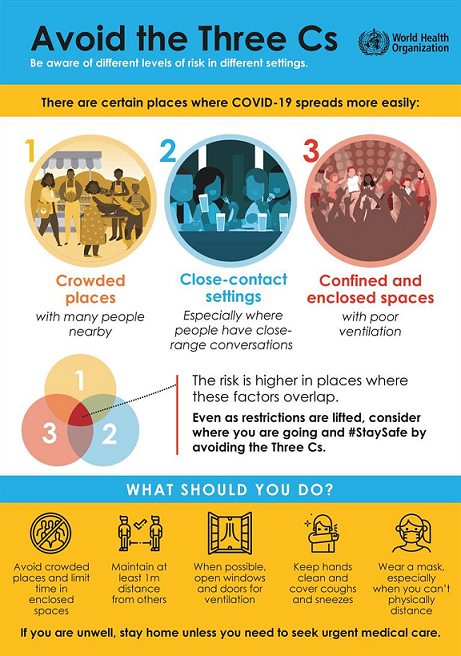أحمد محمد لبن Ahmad.M.Lbn
مؤسس ومدير المنتدى

عدد المساهمات : 52644
العمر : 72
 |  موضوع: How is it transmitted? موضوع: How is it transmitted?  الأحد 10 يناير 2021, 1:43 am الأحد 10 يناير 2021, 1:43 am | |
| 
Coronavirus disease (COVID-19):
How is it transmitted?
9 July 2020
Q&A
How does COVID-19 spread between people?
COVID-19 is caused by the SARS-CoV-2 virus, which spreads between people, mainly when an infected person is in close contact with another person.
The virus can spread from an infected person’s mouth or nose in small liquid particles when they cough, sneeze, speak, sing or breathe heavily.
These liquid particles are different sizes, ranging from larger ‘respiratory droplets’ to smaller ‘aerosols’.
Other people can catch COVID-19 when the virus gets into their mouth, nose or eyes, which is more likely to happen when people are in direct or close contact (less than 1 metre apart) with an infected person.
Current evidence suggests that the main way the virus spreads is by respiratory droplets among people who are in close contact with each other.
Aerosol transmission can occur in specific settings, particularly in indoor, crowded and inadequately ventilated spaces, where infected person(s) spend long periods of time with others, such as restaurants, choir practices, fitness classes, nightclubs, offices and/or places of worship.
More studies are underway to better understand the conditions in which aerosol transmission is occurring outside of medical facilities where specific medical procedures, called aerosol generating procedures, are conducted.
The virus can also spread after infected people sneeze, cough on, or touch surfaces, or objects, such as tables, doorknobs and handrails.
Other people may become infected by touching these contaminated surfaces, then touching their eyes, noses or mouths without having cleaned their hands first.
Find out more about the science about how the SARS-CoV-2 virus infects the body and how our body’s immune system reacts by watching or reading this interview with WHO’s technical lead for COVID-19, Dr Maria Van Kerkhove.
When do infected people transmit the virus?
Whether or not they have symptoms, infected people can be contagious and the virus can spread from them to other people.
Laboratory data suggests that infected people appear to be most infectious just before they develop symptoms (namely 2 days before they develop symptoms) and early in their illness. People who develop severe disease can be infectious for longer.
While someone who never develops symptoms can pass the virus to others, it is still not clear how frequently this occurs and more research is needed in this area.
What is the difference between people who are asymptomatic or pre-symptomatic? Don’t they both mean someone without symptoms?
Both terms refer to people who do not have symptoms.
The difference is that ‘asymptomatic’ refers to people who are infected but never develop any symptoms, while ‘pre-symptomatic’ refers to infected people who have not yet developed symptoms but go on to develop symptoms later.
Are there certain settings where COVID-19 can spread more easily?
Any situation in which people are in close proximity to one another for long periods of time increases the risk of transmission.
Indoor locations, especially settings where there is poor or no ventilation, are riskier than outdoor locations.
Transmission can occur more easily in the “Three C’s”:
Crowded places with many people nearby;
Close-contact settings, especially where people have conversations very near each other;
Confined and enclosed spaces with poor ventilation.
The risk of COVID-19 spreading is higher in places where these “3Cs” overlap.

In health facilities, some medical procedures, called aerosol generating procedures, can produce very small droplets (called ‘droplet nuclei’ or ‘aerosols’) that can stay suspended in the air for longer periods of time.
This is why health workers performing these procedures take specific airborne protection measures, including using appropriate personal protective equipment, including respirators, and why visitors are not permitted in areas in which these procedures are being performed.
How can I reduce my risk of getting COVID-19?
To limit the risks of getting COVID-19 follow these basic precautions:
Follow local guidance. Check to see what national, regional and local authorities are advising so you have the most relevant information for where you are.
Stay at least 1 metre away from others, even if they don’t appear to be sick.
Wear a mask, especially when you can’t physically distance.
Read our Masks and COVID-19 Q&A and watch our videos on how to wear and make masks.
Manage your risks by thinking about location and setting of the event, proximity to others and time you will be at the event.
In other words, consider where you are going, how close you will be to other people and how long you will be there.
Avoid crowded places and events, poorly ventilated indoor locations and prolonged contact with others.
Read our Q&A about how to stay safe when attending and organizing small gatherings
Open windows when indoors to increase the amount of outdoor air.
Read our Q&A about ventilation and air conditioning and COVID-19.
Avoid touching surfaces, especially in public settings, because someone with COVID-19 could have touched them before.
Clean surfaces regularly with standard disinfectants.
Frequently clean your hands with soap and water, or an alcohol-based hand rub.
If you can, carry alcohol-based rub with you and use it often.
Cover your coughs and sneezes with a bent elbow or tissue, throwing used tissues into a closed bin right away.
Then wash your hands or use an alcohol-based hand rub.
Read our public advice page for more information.
Source:
https://www.who.int/news-room/q-a-detail/coronavirus-disease-covid-19-how-is-it-transmitted
|
|







